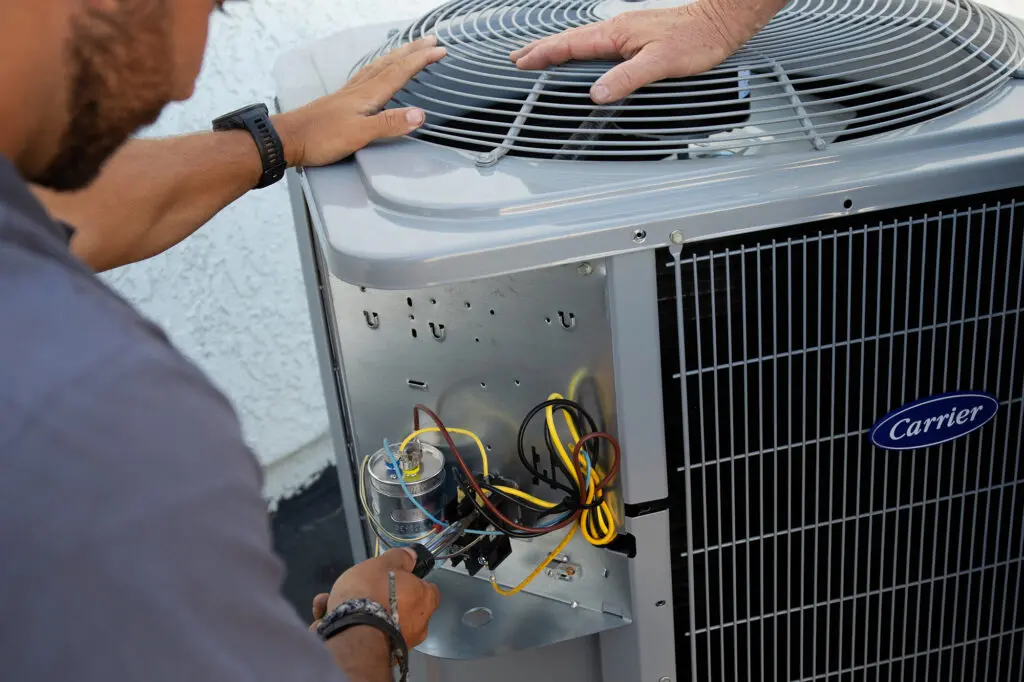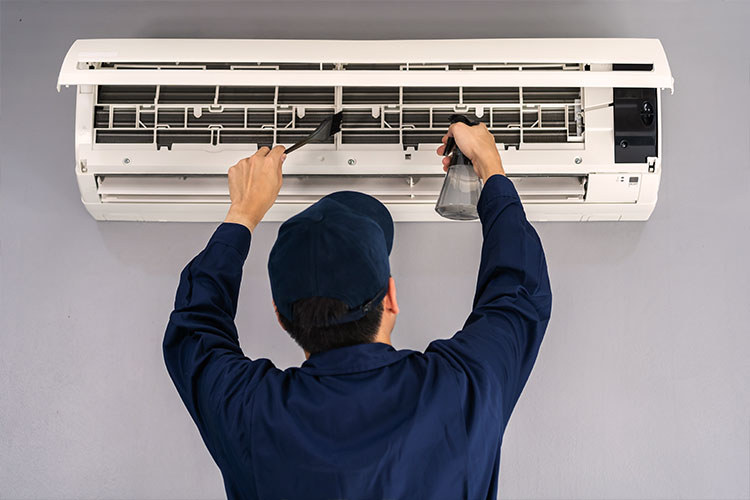Some Known Facts About Air Conditioning Repair.
Some Known Facts About Air Conditioning Repair.
Blog Article
Ac Fixing: Repair Work The Cooling System To Restore Comfortable Indoor Temperatures
Identifying Common A/c Problems
Ever discovered yourself sweltering in the middle of a heatwave, only to understand your air conditioning system isn't cooling as it should? It's discouraging, but more typical than you might believe. Numerous property owners deal with these issues yearly, from strange sounds to unequal airflow. Why does this occur?
Leading Concerns That Often Appear
- Refrigerant Leaks: When the cooling agent leaks, the AC struggles to chill the air, leaving you with hot blasts instead of refreshing breezes.
- Frozen Evaporator Coils: Ever observed ice buildup? It's a sign the system's working overtime or air flow is blocked.
- Clogged Air Filters: Dust and particles can choke the system, causing it to labor harder and potentially get too hot.
- Faulty Thermostat: Sometimes, the culprit is as basic as a misreading thermostat, sending out incorrect signals to your unit.
- Drainage Issues: Water pooling around the unit? Obstructed drain lines might be the sneaky villain here.
How to Recognize These Issues Early
Is your a/c making odd noises-- a grinding or rattling? That's a red flag. Or has your electrical expense mysteriously skyrocketed without a modification in usage? Inadequacy frequently hides behind such hints.

| Symptom | Possible Cause | Quick Repair Pointer |
|---|---|---|
| Warm air blowing | Low refrigerant or compressor failure | Check refrigerant levels; call an expert for compressor issues |
| Unit will not turn on | Electrical issues or thermostat malfunction | Reset breaker; change thermostat batteries |
| Water leak | Clogged drain line | Clear drain with a wet/dry vacuum |
Why Do These Problems Take place?
Consider your air conditioner as a delicate ecosystem. Interrupt one part, and the entire system stumbles. Often, it's overlook-- a forgotten filter modification-- or external factors like power surges. What's clear is that neglecting early indications just turns minor glitches into significant headaches.
Essential Tools for Air Conditioning Repair Work
Ever discovered yourself staring at a frozen evaporator coil or a persistent compressor that declines to hum back to life? You'll quickly read more understand that having the right tools isn't simply a benefit-- it's a requirement. Think of attempting to evaluate refrigerant pressure with a damaged gauge or patching a leakage without an appropriate vacuum pump. The aggravation is real, but the option depends on preparation.
Core Tools Every Service Technician Ought To Have

- Manifold Gauge Set: For accurate measurement of refrigerant pressures-- this is your diagnostic compass.
- Vacuum Pump: Eliminating wetness and air from the system is critical; avoiding this step dangers contamination.
- Multimeter: Electrical power streams calmly, but a multimeter speaks volumes about voltage, current, and continuity.
- Fin Comb: Bent fins on the condenser can choke airflow. This basic tool restores airflow effectiveness rapidly.
- Refrigerant Leakage Detector: Pinpoint evasive leaks that might otherwise fly under the radar.
Pro Tips for Using Your Tools
- Never link evaluates without first verifying the system is off. It avoids damage to your instruments and safeguards your fingers.
- When utilizing the vacuum pump, run it for a minimum of 30 minutes to ensure all moisture is extracted-- shortcuts here result in system failure.
- Adjust your multimeter routinely; even small inaccuracies can misguide fixing efforts.
- Use the fin comb carefully; extreme force can cause more damage.
What's often ignored is how these tools interplay. For example, a refrigerant leak detector guides where to link your manifold assesses to assess pressure drops precisely. Have you ever observed how a simple tool swap can shave hours off a repair task? That's the kind of performance every professional yearns for.
Step-by-Step Repair Instructions for Your Air Conditioner
Ever stood sweating while looking at a stubborn air conditioning unit that refuses to cool? The buzzing hum that unexpectedly turns into silence can be maddening. How do you even start to untangle this web of mechanical wrongdoing? Let's cut through the confusion with a clear, expert-guided process.
1. Detect the Core Concern
Before diving into repair work, ask: is the problem electrical, mechanical, or refrigerant-related? A fast test-- shut off the system and examine the circuit breaker. Tripped breakers typically hide the source. Next, examine the thermostat settings. In some cases, the fix is as simple as recalibrating your thermostat or replacing its batteries.
2. Examine the Air Filter and Coils
A stopped up filter or unclean coils can choke your air conditioner's efficiency. Pull out the filter:
- If it looks dirty or dirty, swap it right away.
- Use a vacuum or soft brush to clean the evaporator coils carefully.
Keep in mind, a disregarded filter is like attempting to breathe through a scarf in a sauna-- ineffective and discouraging.
3. Take A Look At the Condensate Drain
Blocked drains pipes lead to water accumulation, activating sensor shutdowns. Utilize a stiff wire or a wet/dry vacuum to clear the drain line. This quick fix prevents leaks that can trigger larger headaches.
4. Check the Capacitor and Fan Motor
These parts frequently fail silently. Utilizing a multimeter, inspect the capacitor for voltage consistency. If readings fluctuate wildly or read no, replacement remains in order. For the fan motor, listen for grinding or irregular spinning-- indications of impending failure.
Quick Recommendation Table: Common Signs and Fixes
| Symptom | Probable Cause | Expert Idea |
|---|---|---|
| AC not cooling | Unclean filter or low refrigerant | Clean filter first; look for leaks with soapy water |
| System won't begin | Tripped breaker or faulty capacitor | Reset breaker; test capacitor with multimeter |
| Water dripping inside | Obstructed condensate drain | Clear drain line to prevent overflow |
Now, you might question, "Is it truly worth attempting to repair this myself?" Consider this: lots of repairs hinge on perseverance and the right tools instead of raw technical skill. A constant hand and a little troubleshooting can conserve hours and dollars. As with any intricate maker, the key depend on understanding its language-- the hums, clicks, and silences-- and reacting appropriately.
Unlocking Durability: Preventive Upkeep Tips for Air Conditioner Units
Ever seen how a whispering breeze can develop into a stifling furnace when your ac system falters? That subtle hum is often the very first sign of hidden strain. Overlooking these whispers can result in a total breakdown just when you require cool relief one of the most. However what if you could catch these early murmurs before they escalate?
Start with the filter. It's easy to ignore, yet a clogged up filter chokes airflow, requiring your system to work overtime and spike energy intake. Changing or cleaning up filters every 1 month during peak use isn't simply good practice; it's a lifesaver for your air conditioner's performance.
Key Preventive Steps:
- Examine the coils: Dirt accumulation on evaporator and condenser coils decreases heat absorption and release. A gentle brush or vacuum can restore their pristine condition.
- Clear the condensate drain: Blockages here can cause water damage and boost indoor humidity. An easy wire or compressed air blast can keep this course clear.
- Inspect refrigerant levels: Too low, and your air conditioning strains to cool; expensive, and it runs the risk of compressor damage. Just accredited professionals need to handle refrigerant adjustments.
- Evaluate the thermostat's precision to prevent unneeded biking or pain.
Remember the story of the old system that froze strong one summer? The culprit was a small leak that sneaked previous undetected. Little problems frequently mimic typical wear but compound rapidly. Remaining ahead with regular inspections and seasonal tune-ups can prevent these concealed interruptions.
| Maintenance Job | Frequency | Impact |
|---|---|---|
| Filter Replacement | Every one month | Enhances airflow and lowers stress |
| Coil Cleaning | Annually | Boosts heat exchange effectiveness |
| Drain Cleaning | Quarterly | Avoids water damage and mold growth |
| Refrigerant Inspect | Yearly | Ensures ideal cooling efficiency |
Isn't it curious how the smallest tweaks-- like tightening loose electrical connections or lubing moving parts-- can spin your a/c back to peak form? These aren't simply repairs; they're investments in comfort. After all, a properly maintained unit doesn't just cool; it whispers cool calmness, even in the most sweltering heat.
Air Conditioner Repair Providers in Jacksonville, FL
Jacksonville, FL, is a dynamic city known for its extensive park system, beautiful beaches, and busy cultural scene. As the most populous city in Florida, it offers a diverse range of outdoor activities consisting of fishing, boating, and exploring the Timucuan Ecological and Historic Preserve. The city's warm climate makes air conditioning an important part of everyday convenience for citizens and services alike.
For those requiring to repair a/c unit, Bold City Heating and Air offers expert assessment and recommendations. They are prepared to help ensure your cooling system runs effectively through Jacksonville's hot seasons. Reach out to them for a free assessment to resolve your cooling repair work needs.
Report this page